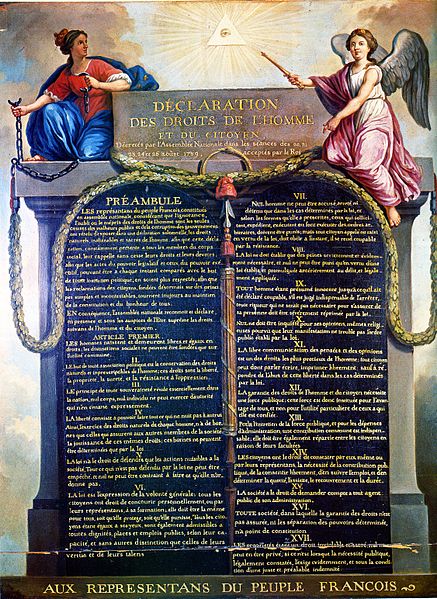|
|||
|
Philatelia.Net / French revolution / Plots / The directory «Plots»Adoption of the Declaration of the Rights of Man and of the CitizenThe Declaration of the Rights of Man and of the Citizen is a fundamental document of the French Revolution, defining the individual and collective rights of all the estates of the realm as universal. Influenced by the doctrine of "natural right", the rights of man are held to be universal: valid at all times and in every place, pertaining to human nature itself. Although it establishes fundamental rights for French citizens and "all the members of the social Body", it addresses neither the status of women nor slavery; despite that, it is a precursor document to international human rights instruments. The last article of Declaration of the Rights of Man and Citizen was adopted 26 August 1789 by the National Constituent Assembly, during the period of the French Revolution, as the first step toward writing a constitution for France. It was prepared and proposed by the Marquis de Lafayette. A second and lengthier declaration, known as the Declaration of the Rights of Man and Citizen of 1793 was later adopted. The concepts in the Declaration come from the philosophical and political principles of the Age of Enlightenment, such as individualism, the social contract as theorized by the French philosopher Rousseau, and the separation of powers espoused by the Baron de Montesquieu. As can be seen in the texts, the French declaration is heavily influenced by the political philosophy of the Enlightenment, and by Enlightenment principles of human rights, some of which it shares with the U.S. Declaration of Independence which preceded it (4 July 1776). Thomas Jefferson, primary author of the U.S. Declaration of Independence, was at the time in France as a U.S. diplomat, and was in correspondence with members of the French National Constituent Assembly. James Madison's proposal for a U.S. Bill of Rights was adopted by the U.S. House of Representatives on 21 August 1789. The declaration is in the spirit of what has come to be called natural law, which does not base itself on religious doctrine or authority. The declaration defines a single set of individual and collective rights for all men. Influenced by the doctrine of natural rights, these rights are held to be universal and valid in all times and places. For example, "Men are born and remain free and equal in rights. Social distinctions may be founded only upon the general good." They have certain natural rights to property, to liberty and to life. According to this theory the role of government is to recognize and secure these rights. Furthermore government should be carried on by elected representatives. At the time of writing, the rights contained in the declaration were only awarded to men. Furthermore, the declaration was a statement of vision rather than reality. The declaration was not deeply rooted in either the practice of the West or even France at the time. The declaration emerged in the late 18th Century out of war and revolution. It encountered opposition as democracy and individual rights were frequently regarded as synonymous with anarchy and subversion. The declaration embodies ideals and aspirations towards which France pledged to struggle in the future. Argentina, 1989, «All Men are Born Free and Equal» Belgium, 1989, Hand of God Benin, 1989, Storming the Bastille, french stamp Central African Republic, 1989, Declaration of Rights of Man Comoren Islands, 1989, Lafayette, Mounier and Sieyes Cote d’Ivoire, 1989, Bastille and detail of Declaration of Rights of Man Djibouti, 1989, Declaration and People France, 1989, Fraternity France, 1989, Declaration of Rights of Man France, 1989, Declaration of Rights of Man Ghana, 1989, Declaration of Human Rights Mauritanie, 1989, Men of Different Races embracing Mozambique, 1989, Declaration of Human Rights New Caledonia, 1989, Liberty New Caledonia, 1989, Equality New Caledonia, 1989, Fraternity New Caledonia, 1989, Liberty, Equality, Fraternity Nicaragua, 1989, La Marseillaise Niger, 1991, Honore de Mirabeau Senegal, 1989, Declaration of Rights of Man St. Lucia, 1989, Revolutionary Declaration, 1789 St. Lucia, 1989, Declaration of Rights of Man St. Pierre and Miquelon, 1989, Liberty St. Pierre and Miquelon, 1989, Equality St. Pierre and Miquelon, 1989, Fraternity Togo, 1989, Declaration of Human Rights Zaire / Congo, 1990, Artilcle I of Declaration of Righs France, 1989.03.18, France, 1989.04.22, France, 1989.05.27, France, 1989.07.07, France, 1989.08.26, New Caledonia, 1989.07.07, USSR, 1989, Advertising: |
|||
© 2003-2026 Dmitry Karasyuk. Idea, preparation, drawing up
|

